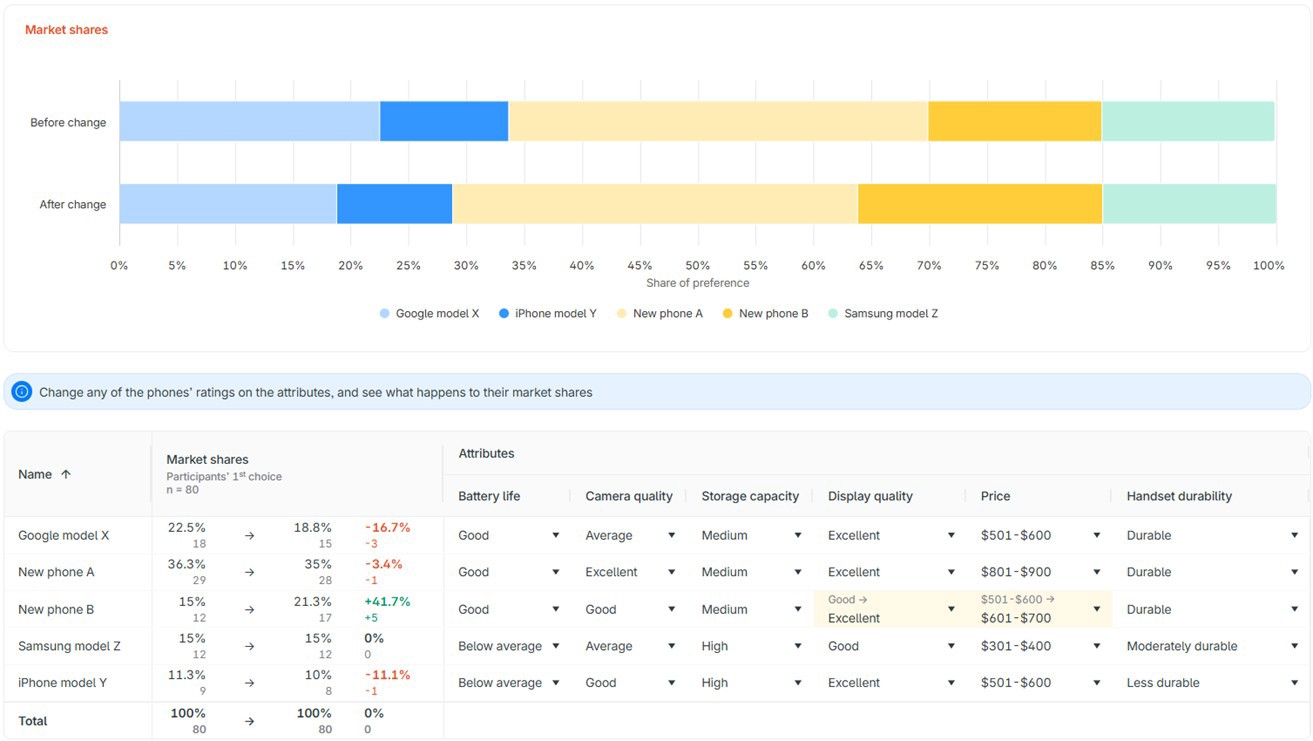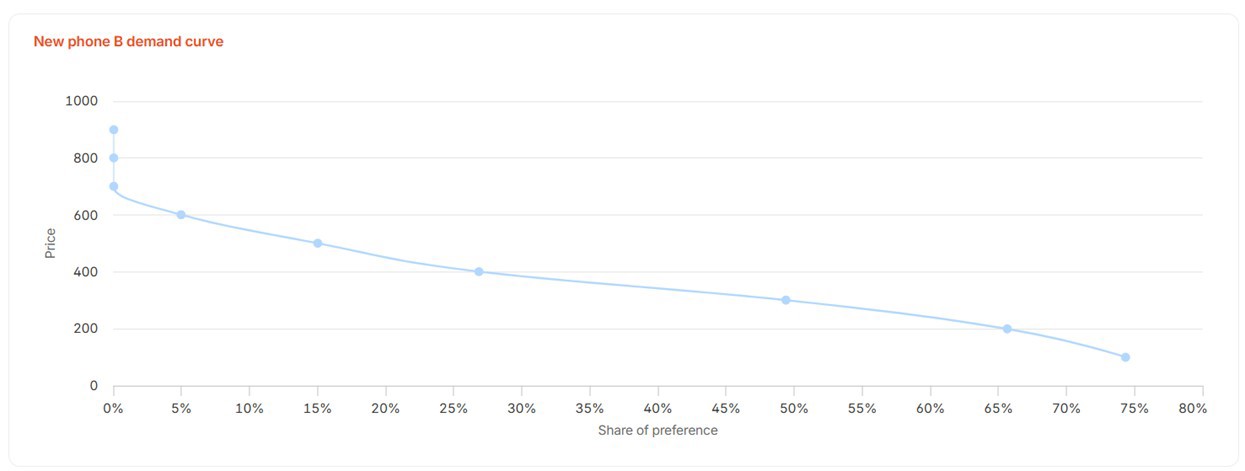In the dynamic environment of product development and strategic marketing, understanding how consumers value the various features of a good or service offered by a business is fundamentally important.
Conjoint analysis – a popular market research technique, also known as a discrete choice experiment (DCE) – is a powerful method for quantifying these preferences.
To take full advantage of the insights offered by conjoint analysis – e.g. for new product design, pricing strategies and competitive positioning – businesses need a bridge between the raw preferences data produced by conjoint analysis and actionable market insights.
This bridge comes in the form of 1000minds’ new market simulator, which translates conjoint-analysis data from 1000minds preferences surveys into simulated market outcomes (or predictions).
The market simulator enables you to model market shares for competing product offerings, gauge consumers’ sensitivity to price changes and generate demand curves.
From conjoint analysis to market simulation
What is conjoint analysis?
Conjoint analysis is a survey-based methodology for discovering people’s preferences that is widely used for market research, new product design and government policy-making.
Conjoint analysis is used to discover how people value the various attributes (features, functions and benefits) that make up a product; or in government policy-making to investigate how citizens feel about a policy’s characteristics.
From people’s answers to a 1000minds preferences survey, their preferences are codified as weights representing the relative importance of the attributes of the product of interest. These weights are often referred to as utilities, also known as part-worths.
These utilities form the inputs for the market simulator.
What is the market simulator?
1000minds’ market simulator takes each participant’s utilities from the preferences survey and simulates people’s real-world market choices: which particular product they would choose from all the ones on offer in the market being simulated.
Of course, a market simulation is just that: a simulation. Simulator results will depend on who participated in the preferences survey – different samples are likely to produce different simulator results.
Also, simulations don’t account for “frictions” present in many real-world applications. The products in the simulator are assumed to be fully known and available to decision-makers in the market being simulated, which is not always true in reality.
Simulating market shares
One of the most compelling uses of the market simulator is modelling the market shares of competing product offerings across different competitive scenarios.
All you need to do to perform a simulation is change any of the ratings on the attributes of the products included in 1000minds, and see what happens to their market shares, i.e. compare their shares before and after your changes.
The market simulator can be used for:
- Head-to-head comparisons: You can create competing product profiles based on their attributes (e.g. feature sets, brand, warranty, etc.) and see how each performs
- “What-if” analysis: Want to see what happens if a competitor reduces their price or adds a premium feature? Just simulate it!
- Imaginary product testing: Before launching a product, test different configurations virtually to predict uptake
As an illustration, imagine a smartphone company thinking about launching a new phone. By modelling possible feature-set configurations and price points, the company can simulate how their phone would fare against models from Apple, Samsung and Google, for example.
The simulated effects on the company’s “New phone A” and “New phone B” of improving B’s display quality and raising its price, relative to the three competing products, are shown in this screenshot.

Price elasticities of demand
Pricing decisions are critically important to the success of any business.
1000minds’ market simulator enables you to test how sensitive, or responsive – referred to as “elastic” – your product’s demand, or market share, is to price changes, both for your product and competitors’ products.
Price elasticities come in two “flavors”, own-price and cross-price elasticity, and are formally measured by calculating elasticity coefficients, represented by the symbol ε (epsilon). Two examples appear below.
Of particular interest are the relative magnitudes of own-price and cross-price ε, as this is critical information for pricing decisions.
For example, depending on its relative magnitude, your product’s own-price ε will imply one of three optimal strategies: you should raise price; or lower price; or don’t change price. It all depends on the relative magnitude of the own-price elasticity coefficient!
Similarly, the relative magnitude of cross-price ε conveys important information about the extent to which consumers view competing products as substitutes.

Demand curves
1000minds’ market simulator also plots demand curves, which represent the relationship between a product’s price and its market share at various prices, as in this example.

Product development and strategic marketing applications
The power of 1000minds’ market simulator lies in its ability to support data-driven business strategies, such as these examples:
- New product development: Before investing millions into R&D, simulate how the new product will perform. Test different feature configurations to find the sweet spot that maximizes consumer demand and revenue.
- Competitive intelligence: Use the market simulator to understand how vulnerable your product is to competitors’ strategies, such as price changes and new features.
- Line optimization and portfolio management: Evaluate whether adding a budget-friendly version or a premium tier could expand the market or cannibalize existing sales. The market simulator provides an evidence-based approach to product line rationalization.
Supercharge your conjoint analysis today
Curious about how 1000minds’ market simulator can help you? Take our AI-assisted conjoint analysis software for a spin by signing up for a free trial or book a demo with our friendly team today.
Share this post on:

